ASUS VivoBook 15 F512 (X512) review – 88% of screen-to-body ratio at a great price
 Here comes another VivoBook creation from ASUS. Expectedly, it bears most of the features we’ve seen on this series of devices (excluding the ScreenPad) and comes at a very affordable price.
Here comes another VivoBook creation from ASUS. Expectedly, it bears most of the features we’ve seen on this series of devices (excluding the ScreenPad) and comes at a very affordable price.
Of course, one of the main features that ASUS blows the whistle about is the so-called NanoEdge display, which results in 88% of screen-to-body ratio (according to them). Indeed, this is a great thing to see on laptops and is made possible by the ErgoLift hinge, which elevates the backside of the base so that it covers most of the bottom bezel of the display. While it can be considered as a kind of cheating in reaching that ratio of screen to the body, it is actually a neat invention.
Hardware-wise, you can pick a model with an Intel chipset, or an AMD one. Naturally, the Intel-equipped devices will come with a Whiskey Lake processor, while the AMD-run ones will embody a 3000 Ryzen U-series CPU. Additionally, the Intel-based laptops are getting the option of a dedicated GPU, whereas the Red company counts on their integrated graphics cards only.
You can check the prices and configurations in our Specs System: https://laptopmedia.com/series/asus-vivobook-15-f512-x512/
Contents
Specs Sheet
- HDD/SSD
- up to 2000GB SSD + up to 1000GB HDD
- RAM
- up to 36GB
- OS
- Windows 10 S, Windows 10 Home, Windows 11 Home, Windows 11 Pro, Windows 10 Pro
- Battery
- 37Wh, 2-cell
- Dimensions
- 357.2 x 230.4 x 19.9 mm (14.06" x 9.07" x 0.78")
- Weight
- 1.75 kg (3.9 lbs)
- Ports and connectivity
- 1x USB Type-A
- 3.2 Gen 1 (5 Gbps)
- 1x USB Type-C
- 3.2 Gen 1 (5 Gbps)
- 2x USB Type-A
- 2.0
- HDMI
- Card reader
- microSD
- Wi-Fi
- 802.11ac
- Bluetooth
- 4.1
- Audio jack
- Headphone/ Microphone combo
- Features
- Fingerprint reader
- optional
- Web camera
- HD
- Backlit keyboard
- optional
- Optical drive
- Security Lock slot
All ASUS VivoBook 15 F512 (X512 / K512 / S512 / A512) configurations
What’s in the box?
Inside the box, accompanying the laptop, there is the mandatory paperwork, as well as a 45W power brick (or 65W one if the device is equipped with a dedicated GPU).
Design and construction
Suiting the low retail price, the VivoBook 15 F512 (X512) is made entirely out of plastic. This results in a 1.75kg body weight and a 19.9 mm profile – a pretty thin and light laptop.
If you would like a device that opens with a single hand than this one is not for you. Additionally, its lid is prone to bends when you twist it. On the bright side, however, is that ErgoLift hinge mechanism. It lifts the laptop’s base no more than a couple of millimeters, but this is enough to give it some breathing space and to make typing ever so slightly more comfortable to you.
Speaking of comfortability during typing, its keyboard is pretty good. It has decent key travel and clicky feedback. Moreover, it includes the Number Pad, despite it is being slightly shrunken. One thing that we don’t particularly like on it, is the color of the keys, which makes it extremely difficult to distinguish one another, because of the reflections from the display. Of course, this would not be the case if you order the laptop with a backlit keyboard. In addition to that, the touchpad is very fast and snappy.
Things are pretty minimalistic on the bottom plate. There is only one small grill for the fan, as well as two on the front corners of the device, meant for the speakers.
Ports
On the left side there are two USB Type-A 2.0 ports, that would serve for peripheral connections, while on the right you can find the barrel-style power plug, a USB Type-A 3.1 (Gen. 1) port, an HDMI connector, a USB Type-C 3.1 (Gen. 1) port, a combo audio jack as well as a MicroSD card reader.
Disassembly, upgrade options and maintenance
Not so different from the VivoBook S15 S532, the VivoBook 15 F512 (X512) has 10 Phillips head screws that hold the bottom plate in its place. After you remove them, there is some prying action that you need to do before you take it off. And on the inside?
On the inside, there is a somewhat similar picture to the ASUS X509. It is concerning the cooling solution. However, in contrast to the former, the VivoBook 15 F512 (X512) has a single heat pipe that leads to a supposed heat spreader on its right. Then a fan is blowing the heat away from it. Interestingly, the aforementioned heat spreader is not placed on the edge of the laptop but on where a dedicated GPU would sit.
As far as upgradability – there is one RAM DIMM available, with 4 GB already soldered to the motherboard. Moreover, there is an M.2 slot and a 2.5″ SATA slot beneath it.
Battery-wise, the capacity is 37Wh, which is clearly not the biggest we’ve seen.
Display quality
ASUS VivoBook 15 F512 (X512) is equipped with a Full HD TN panel with a model number Innolux N156HGA-EA3 (CMN15F5). Its diagonal is 15.6″ (39.62 cm), and the resolution 1920 х 1080 pixels. The screen ratio is 16:9, and we are looking at a pixel density of – 142 ppi, and a pitch of 0.18 х 0.18 mm. The screen turns into Retina when viewed at distance equal to or greater than 60cm (24″) (from this distance one’s eye stops differentiating the separate pixels, and it is normal for looking at a laptop).
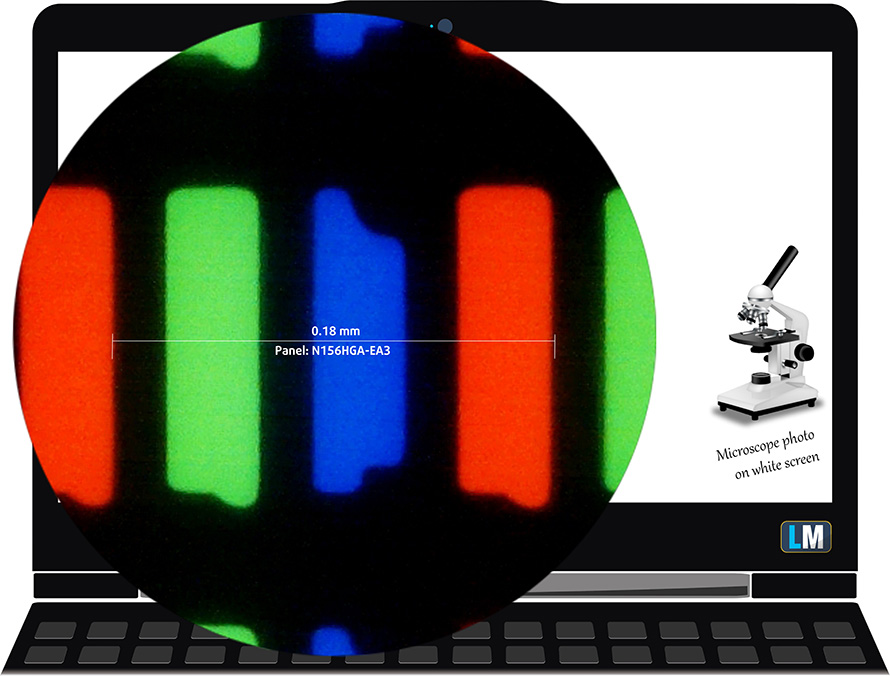
As expected from a TN panel – the viewing angles are terrible. We offer images at 45° to evaluate image quality.

The measured maximum brightness of 241 nits in the middle of the screen and 218 nits as an average for the whole area, with a maximum deviation of 17%, in the top left corner. The Correlated Color Temperature on a white screen is 6000K – warmer than the optimal for the sRGB standard of 6500K. This changes to 9500K (cold, bluish light) when we go to the gray areas. This is corrected by our profiles.
In the illustration below you can see how the display performs from a uniformity perspective. In other words, the leakage of light from the light source.
Values of dE2000 over 4.0 should not occur, and this parameter is one of the first you should check if you intend to use the laptop for color-sensitive work. The contrast ratio is mediocre – 390:1 (330:1 after profiling).
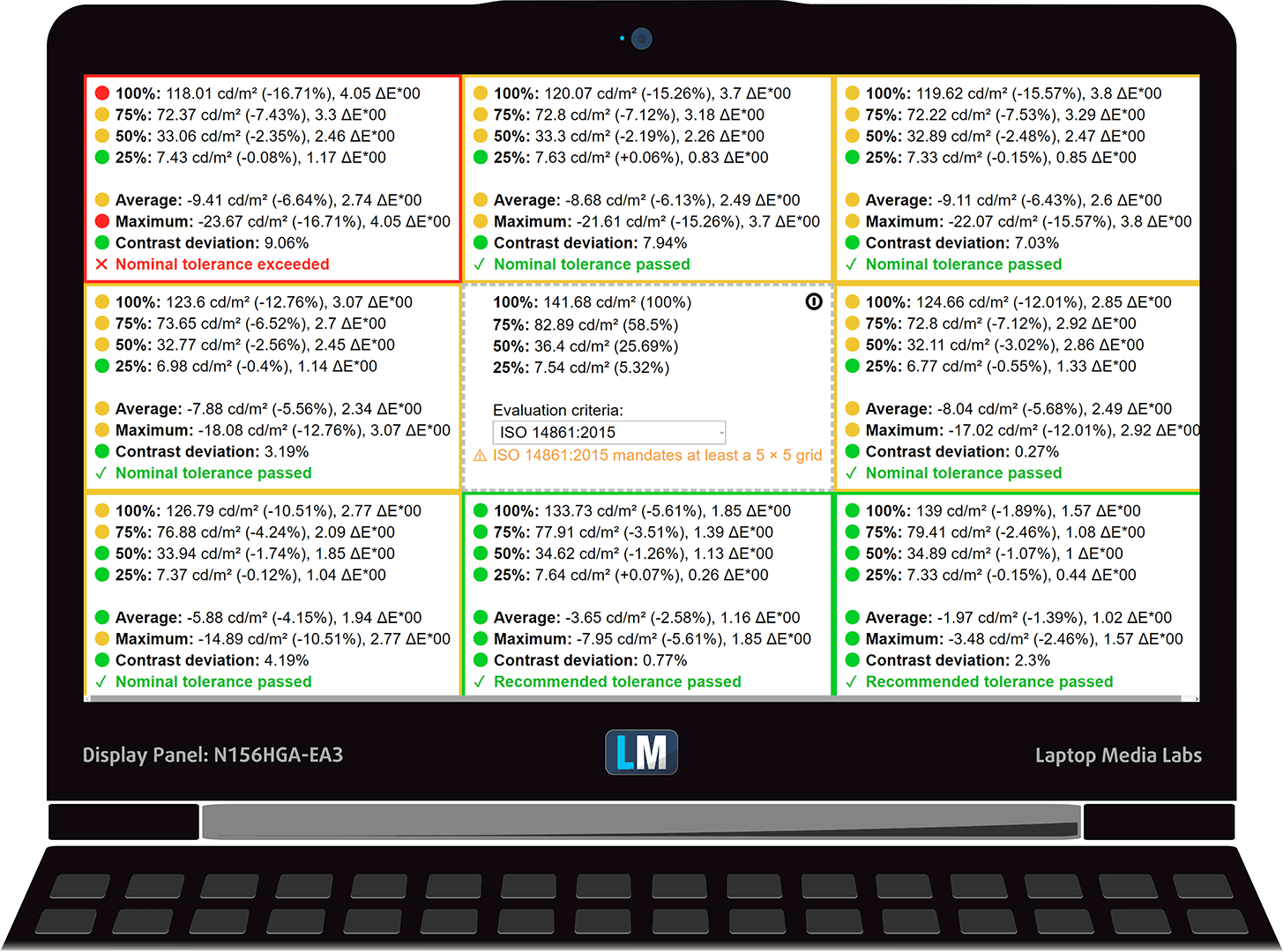
To make sure we are on the same page, we would like to give you a little introduction to the sRGB color gamut and the Adobe RGB. To start, there’s the CIE 1976 Uniform Chromaticity Diagram that represents the visible specter of colors by the human eye, giving you a better perception of the color gamut coverage and the color accuracy.
Inside the black triangle, you will see the standard color gamut (sRGB) that is being used by millions of people in HDTV and on the web. As for the Adobe RGB, this is used in professional cameras, monitors, etc for printing. Basically, colors inside the black triangle are used by everyone and this is the essential part of the color quality and color accuracy of a mainstream notebook.
Still, we’ve included other color spaces like the famous DCI-P3 standard used by movie studios, as well as the digital UHD Rec.2020 standard. Rec.2020, however, is still a thing of the future and it’s difficult for today’s displays to cover that well. We’ve also included the so-called Michael Pointer gamut, or Pointer’s gamut, which represents the colors that naturally occur around us every day.
The yellow dotted line shows ASUS VivoBook 15 F512 (X512)’s color gamut coverage.
Its display covers 54% of the sRGB/ITU-R BT.709 (web/HDTV standard) in CIE1976.
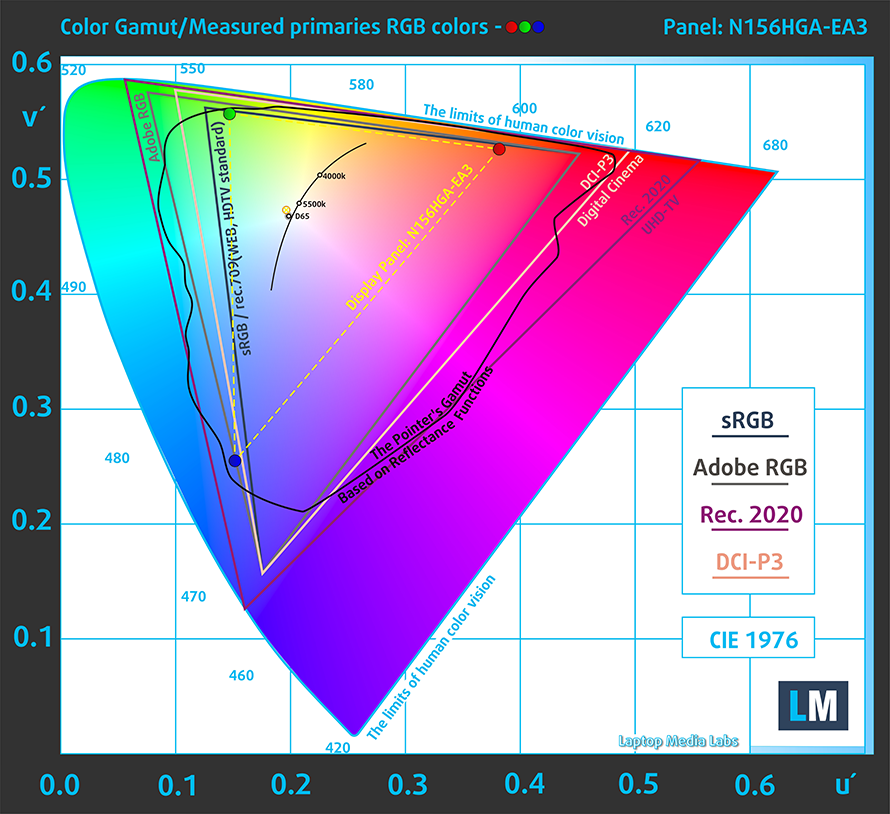
Our “Design and Gaming” profile delivers optimal color temperature (6500K) at 140 cd/m2 luminance and sRGB gamma mode.
We tested the accuracy of the display with 24 commonly used colors like light and dark human skin, blue sky, green grass, orange, etc. You can check out the results at factory condition and also, with the “Design and Gaming” profile.
Below you can compare the scores of ASUS VivoBook 15 F512 (X512) with the default settings (left), and with the “Gaming and Web design” profile (right).
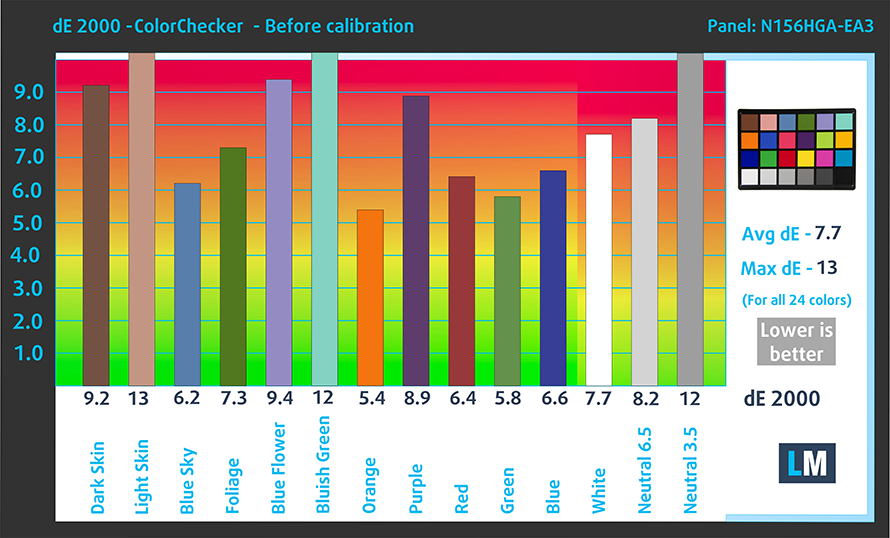
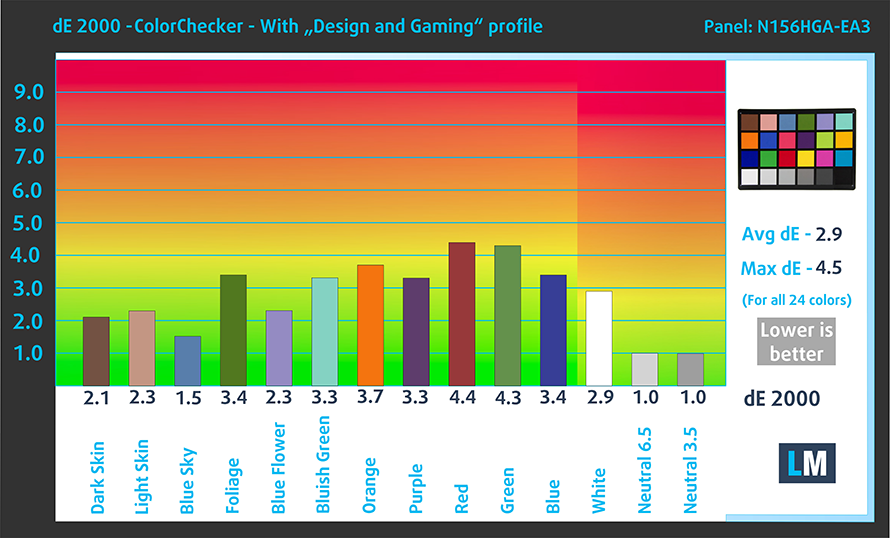
The next figure shows how well the display is able to reproduce really dark parts of an image, which is essential when watching movies or playing games in low ambient light.
The left side of the image represents the display with stock settings, while the right one is with the “Gaming and Web Design” profile activated. On the horizontal axis, you will find the grayscale and on the vertical axis – the luminance of the display. On the two graphs below you can easily check for yourself how your display handles the darkest nuances but keep in mind that this also depends on the settings of your current display, the calibration, the viewing angle, and the surrounding light conditions.

Response time (Gaming capabilities)
We test the reaction time of the pixels with the usual “black-to-white” and “white-to-black” method from 10% to 90% and vice versa.
We recorded Fall Time + Rise Time = 11 ms.
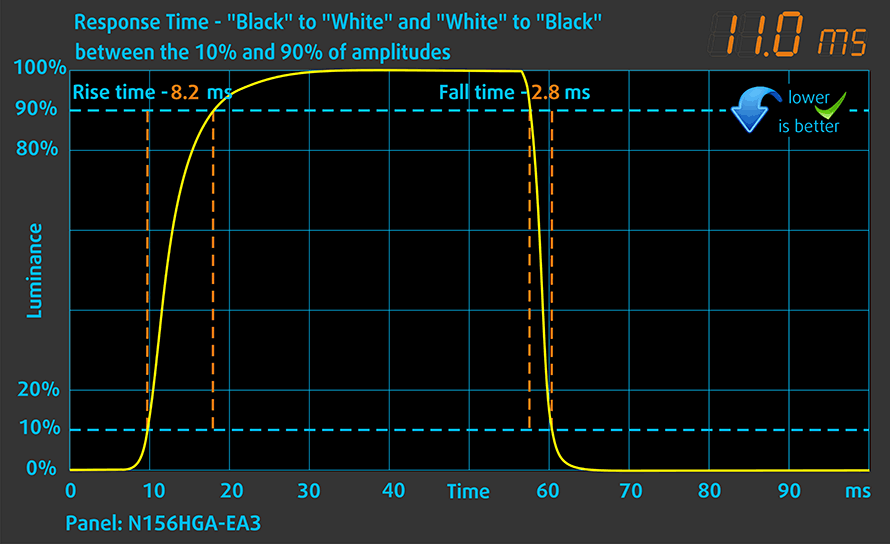
PWM (Screen flickering)
Pulse-width modulation (PWM) is an easy way to control monitor brightness. When you lower the brightness, the light intensity of the backlight is not lowered, but instead turned off and on by the electronics with a frequency indistinguishable to the human eye. In these light impulses, the light/no-light time ratio varies, while brightness remains unchanged, which is harmful to your eyes. You can read more about that in our dedicated article on PWM.
ASUS VivoBook 15 F512 (X512)’s display is PW-modulated until 63 nits. Moreover, the flickerings have a very high frequency, which makes the display comfortable for long work periods.
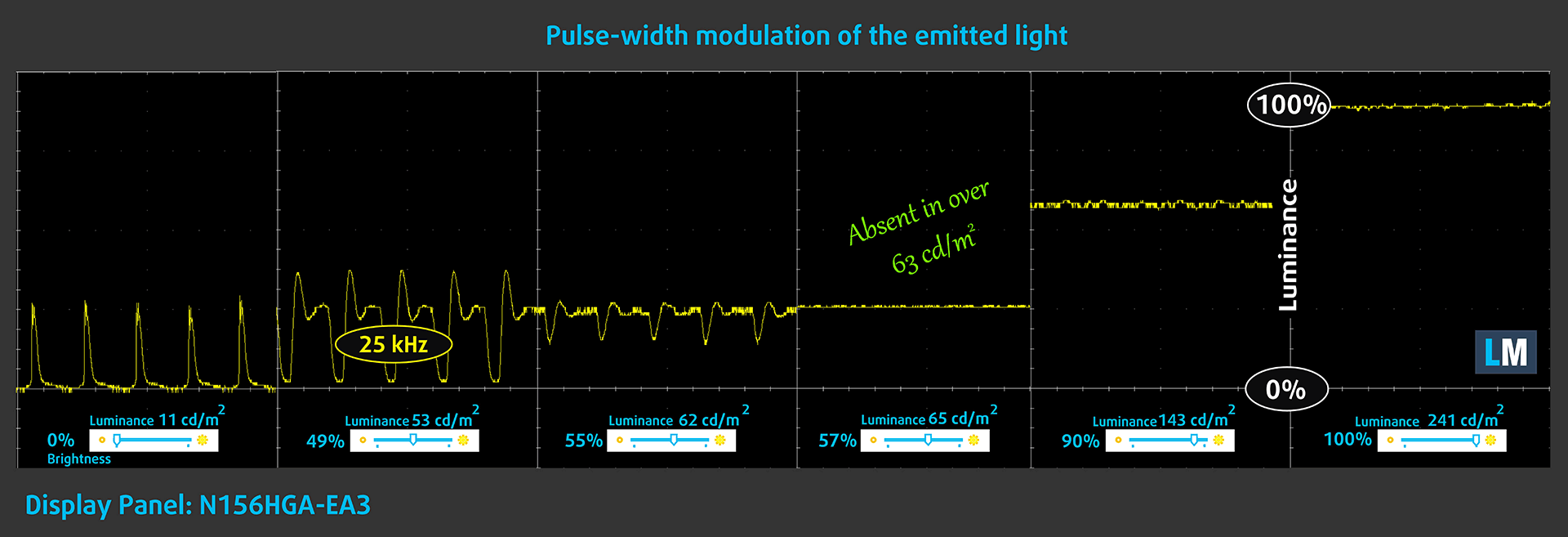
Blue light emissions
Installing our Health-Guard profile not only eliminates PWM but also reduces the harmful Blue Light emissions while keeping the colors of the screen perceptually accurate. If you’re not familiar with the Blue light, the TL;DR version is – emissions that negatively affect your eyes, skin and your whole body. You can find more information about that in our dedicated article on Blue Light.
Conclusion
This laptop’s TN panel has a Full HD resolution, fast-reacting pixels and its backlight doesn’t use aggressive PWM. On the downside, it has uncomfortable viewing angles, poor contrast ratio, and modest color coverage.
Buy our profiles
Since our profiles are tailored for each individual display model, this article and its respective profile package are meant for ASUS VivoBook 15 F512 (X512) configurations with 15.6″ FHD TN Innolux N156HGA-EA3 (CMN15F5).
*Should you have problems with downloading the purchased file, try using a different browser to open the link you’ll receive via e-mail. If the download target is a .php file instead of an archive, change the file extension to .zip or contact us at [email protected].
Read more about the profiles HERE.
In addition to receiving efficient and health-friendly profiles, by buying LaptopMedia's products you also support the development of our labs, where we test devices in order to produce the most objective reviews possible.

Office Work
Office Work should be used mostly by users who spend most of the time looking at pieces of text, tables or just surfing. This profile aims to deliver better distinctness and clarity by keeping a flat gamma curve (2.20), native color temperature and perceptually accurate colors.

Design and Gaming
This profile is aimed at designers who work with colors professionally, and for games and movies as well. Design and Gaming takes display panels to their limits, making them as accurate as possible in the sRGB IEC61966-2-1 standard for Web and HDTV, at white point D65.

Health-Guard
Health-Guard eliminates the harmful Pulse-Width Modulation (PWM) and reduces the negative Blue Light which affects our eyes and body. Since it’s custom tailored for every panel, it manages to keep the colors perceptually accurate. Health-Guard simulates paper so the pressure on the eyes is greatly reduced.
Get all 3 profiles with 33% discount
Sound
ASUS VivoBook 15 F512 (X512) produces a relatively loud sound with good quality. The speakers are tuned by SonicMaster and its low, mid and high tones are clear of deviations.
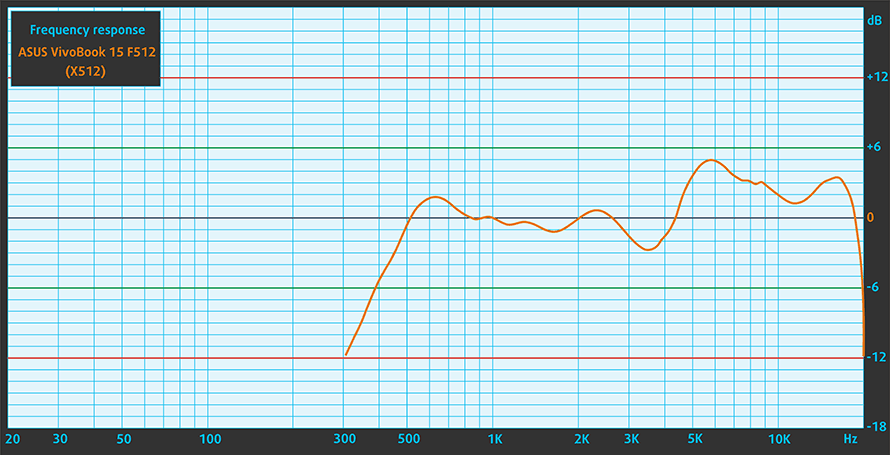
Drivers
All of the drivers and utilities for this laptop can be found here: https://www.asus.com/Laptops/ASUS-VivoBook-15-X512FB/HelpDesk_Download/
Battery
Now, we conduct the battery tests with Windows Better performance setting turned on, screen brightness adjusted to 120 nits and all other programs turned off except for the one we are testing the notebook with. Capacity-wise, the VivoBook 15 F512 is equipped with a 37Wh unit.
However, thanks to the good optimization by the guys at ASUS, the laptop was able to achieve 8 hours of Web browsing and nearly 7 hours of video playback.
In order to simulate real-life conditions, we used our own script for automatic web browsing through over 70 websites.
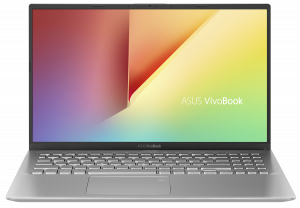
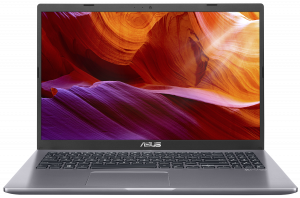

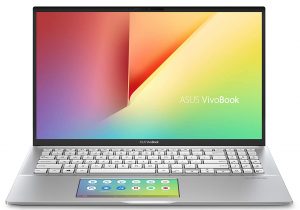
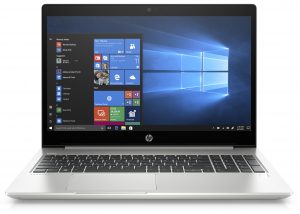
For every test like this, we use the same video in HD.





CPU options
Okay guys, so as we mentioned, the laptop is offered in both Intel and AMD variants. The Intel options include the Core i3-8145U, Core i5-8265U, and the Core i7-8565U, while the AMD ones come with Ryzen 3 3200U, Ryzen 5 3500U and Ryzen 7 3700U.
Results are from the Cinebench 20 CPU test (the higher the score, the better)
Results are from our Photoshop benchmark test (the lower the score, the better)
ASUS VivoBook 15 F512 (X512 / K512 / S512 / A512) CPU variants
Here you can see an approximate comparison between the CPUs that can be found in the ASUS VivoBook 15 F512 (X512 / K512 / S512 / A512) models on the market. This way you can decide for yourself which ASUS VivoBook 15 F512 (X512 / K512 / S512 / A512) model is the best bang for your buck.
Note: The chart shows the cheapest different CPU configurations so you should check what the other specifications of these laptops are by clicking on the laptop’s name / CPU.
Results are from the Cinebench 20 CPU test (the higher the score, the better)
Results are from our Photoshop benchmark test (the lower the score, the better)
GPU options
GPU-wise the choices is between the integrated Intel UHD Graphics 620, AMD’s Vega 3,8 and 10, as well as the NVIDIA GeForce MX130 and MX230. Now that is quite the pool to choose from.
Results are from the 3DMark: Time Spy (Graphics) benchmark (higher the score, the better)
Results are from the 3DMark: Fire Strike (Graphics) benchmark (higher the score, the better)
Results are from the Unigine Superposition benchmark (higher the score, the better)
ASUS VivoBook 15 F512 (X512 / K512 / S512 / A512) GPU variants
Here you can see an approximate comparison between the GPUs that can be found in the ASUS VivoBook 15 F512 (X512 / K512 / S512 / A512) models on the market. This way you can decide for yourself which ASUS VivoBook 15 F512 (X512 / K512 / S512 / A512) model is the best bang for your buck.
Note: The chart shows the cheapest different GPU configurations so you should check what the other specifications of these laptops are by clicking on the laptop’s name / GPU.
Results are from the 3DMark: Time Spy (Graphics) benchmark (higher the score, the better)
Results are from the 3DMark: Fire Strike (Graphics) benchmark (higher the score, the better)
Results are from the 3DMark: Wild Life (Graphics) benchmark (higher the score, the better)
Results are from the Unigine Superposition benchmark (higher the score, the better)
Gaming tests

| CS:GO | HD 1080p, Low (Check settings) | HD 1080p, Medium (Check settings) | HD 1080p, MAX (Check settings) |
|---|---|---|---|
| Average FPS | 51 fps | 30 fps | – fps |

| DOTA 2 | HD 1080p, Low (Check settings) | HD 1080p, Normal (Check settings) | HD 1080p, High (Check settings) |
|---|---|---|---|
| Average FPS | 71 fps | 35 fps | 15 fps |
Temperatures and comfort
Max CPU load
In this test we use 100% on the CPU cores, monitoring their frequencies and chip temperature. The first column shows a computer’s reaction to a short load (2-10 seconds), the second column simulates a serious task (between 15 and 30 seconds), and the third column is a good indicator of how good the laptop is for long loads such as video rendering.

Average core frequency (base frequency + X); CPU temp.
| AMD Ryzen 7 3700U (15W TDP) | 0:02 – 0:10 sec | 0:15 – 0:30 sec | 10:00 – 15:00 min |
|---|---|---|---|
| ASUS VivoBook 15 F512 (X512) | 3.10 GHz (B+35%) @ 65°C | 3.09 GHz (B+34%) @ 80°C | 2.39 GHz (B+9%) @ 68°C |
| AMD Ryzen 5 3500U (15W TDP) | 0:02 – 0:10 sec | 0:15 – 0:30 sec | 10:00 – 15:00 min |
| Lenovo IdeaPad S540 (14″) | 3.24 GHz (B+54%) @ 60°C | 3.08 GHz (B+47%) @ 66°C | 2.95 GHz (B+40%) @ 72°C |
Interestingly, the AMD Ryzen 7 3700U processor inside this VivoBook 15 F512 (X512) works at lower frequencies than we monitored on the Ideapad S540, which comes with the lower tier Ryzen 5 3500U. On the bright side, the temperatures are maintained pretty well by the freaky cooling solution, but still, it seems that the Ideapad S540 (14″) one offers a better one.
Verdict
 Well, guys, after the time we spent with this laptop we experienced no significant problems with it, whatsoever. Yes, there was a thing or two that we didn’t enjoy that much, but in general, the VivoBook 15 F512 (X512) is solid.
Well, guys, after the time we spent with this laptop we experienced no significant problems with it, whatsoever. Yes, there was a thing or two that we didn’t enjoy that much, but in general, the VivoBook 15 F512 (X512) is solid.
By things we didn’t enjoy we were referring to the color of the characters on the keyboard, which makes them difficult to see, because of the reflection of the display. We learn that some models may come with a backlight that will completely fix the issue. Then, there is the sketchy cooling. While it is not exactly a problem for this device, we saw it perform worse than the Ideapad S540 (14″), which was equipped with a lower-tier CPU.
This laptop’s TN panel has a Full HD resolution, fast-reacting pixels and its backlight doesn’t use aggressive PWM. On the downside, it has uncomfortable viewing angles, poor contrast ratio, and modest color coverage.
Then last, but not least, there is the TN panel, which is essential for the low price point. As you may imagine, it doesn’t present you with the best viewing experience, so if you have found an IPS-equipped laptop at a similar cost, you are better off with it instead.
However, there are some significant thumbs-ups for the VivoBook 15 F512 (X512). One of them is the battery life, which reaches 8 hours during Web browsing and 7 hours during video playback. This is mainly due to the great efficiency of AMD’s new CPUs. Then there is the experience given by the input devices. Yes, we complained about the keyboard, however, we didn’t tell you that is great for typing, while the touchpad only enhances the experience.
When compared to a laptop like the ASUS X509, we think that this one might just have the edge. With its ErgoLift hinge and great screen-to-body ratio, the VivoBook 15 F512 (X512) is clearly one step ahead.
Pros
- Sleek design
- Good battery life thanks to optimizations and efficient hardware
- Sufficient input devices
- Offers decent upgradability
- Has a quick reaction time and lacks aggressive PWM for brightness adjustment (Innolux N156HGA-EA3 (CMN15F5))
Cons
- All-plastic build
- Limited IPS options
- TN display has poor viewing angles and contrast ratio (Innolux N156HGA-EA3 (CMN15F5))
- Covers only 55% of sRGB (Innolux N156HGA-EA3 (CMN15F5))
You can check the prices and configurations in our Specs System: https://laptopmedia.com/series/asus-vivobook-15-f512-x512/
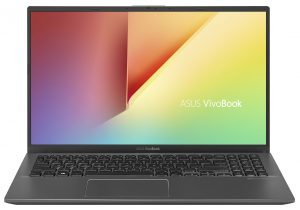

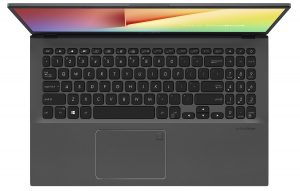
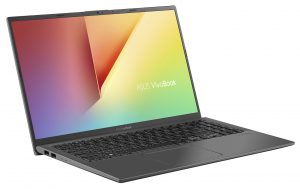
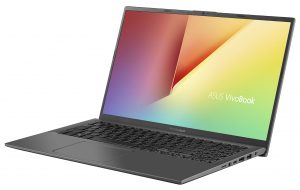
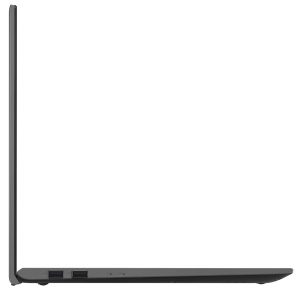
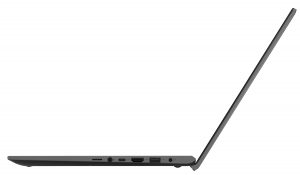


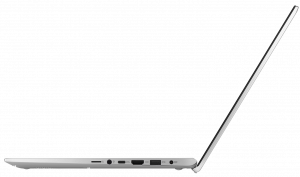
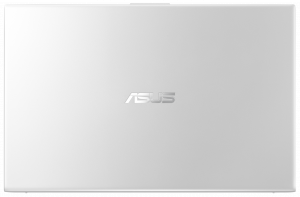
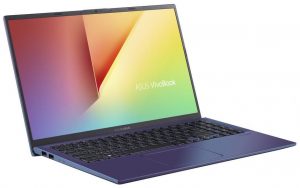
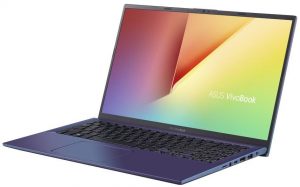
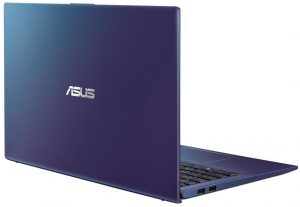
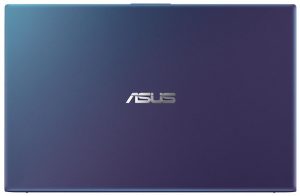
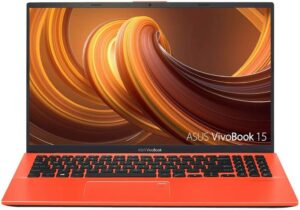
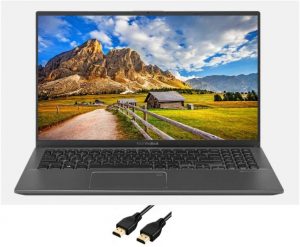


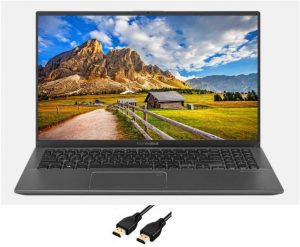
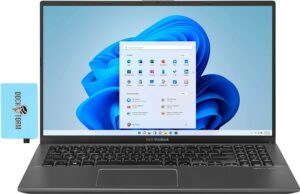
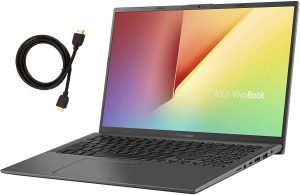
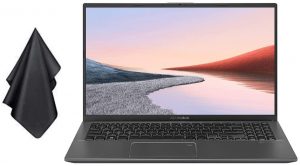
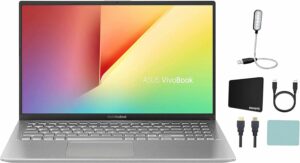
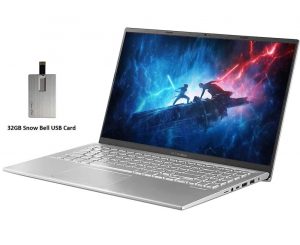
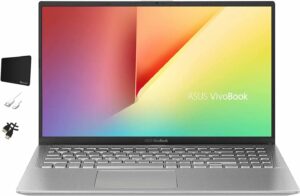
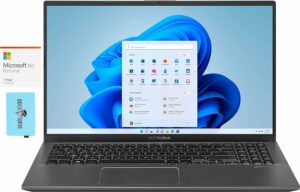
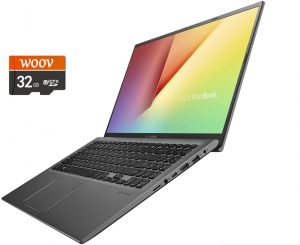



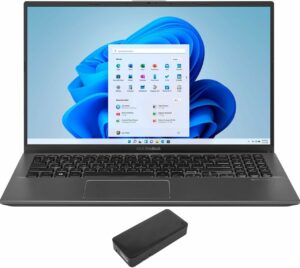
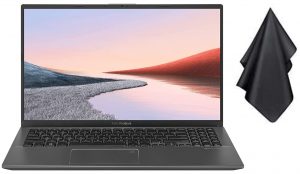




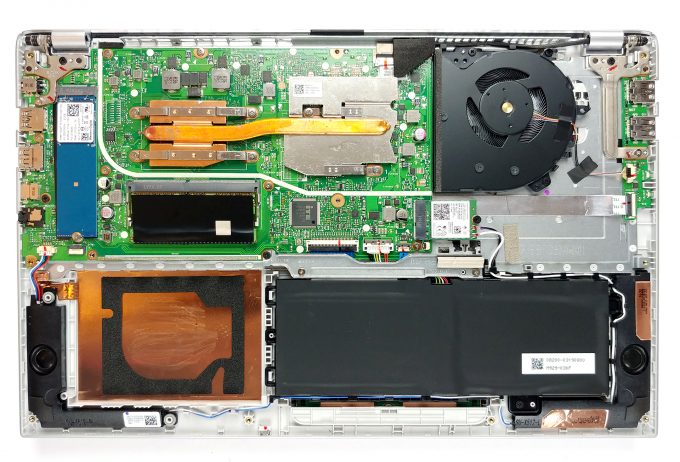
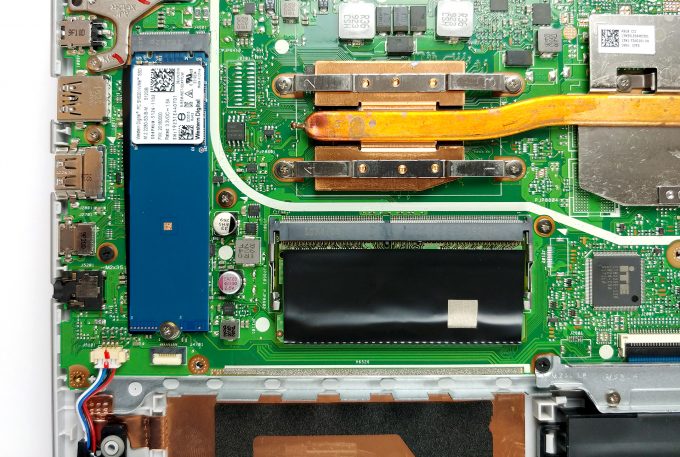
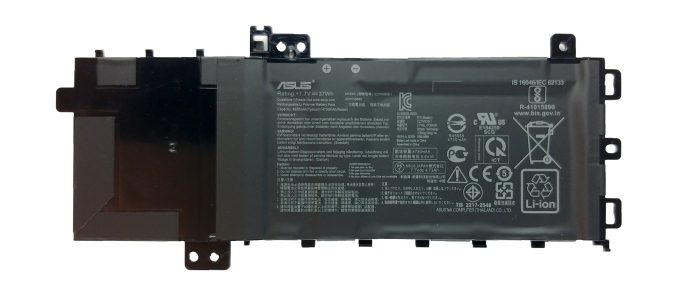









While X512 = F512 > X509, for even better value-for-money, I would go Acer Aspire 5 Slim – cheaper for same specs with IPS screen and not much more weight, plus a metal lid. Only thing stopping me from choosing Acer is the missing vital SD-card slot. Thus, I’m eyeing the F512, i3-8145U, 8GB RAMS with 128GB SSD on Amazon for productivity over entertainment.
“Display quality
We are currently working on the quality tests of the VivoBook 15 F512’s display. Stay tuned!”
Please expedite!
can i use m.2 NVMe ?
The laptop comes with an M.2 NVMe drive stock as far as I know.
From my own testing, this cooling solution isn’t good enough. I have the version with the Ryzen 5 3500U, I ran Prime95 for a few minutes, the CPU boosts to over 3 GHz and temps immediately rise to 97c and the CPU hangs around 2.3-2.6 GHz until eventually throttling down to 1.2 at which point the temps rapidly drop to 70c and the CPU goes to 2.8 until it eventually stabilizes around 2.4, then after some time it throttles all the way down to 1.2 again and the cycle repeats. Also, the Whiskey Lake versions without a GPU have an… Read more »
Hi, I have the same version too. Is there any way to change the keyboard to a backlit one?
Is it possible to add your own HDD or SSD in the slot below the m.2 SSD that’s already on-board? It doesn’t appear like there’s any cable for it, so would you have to get your own? I’m guessing that’s the SATA header for it between the empty space and the m.2 drive…?
There’s a cable and chassis in the box if you buy an SSD version of the X512
Mine didn’t come with it, any suggestions on were can I find it, I have de SSD already but not the adapter or the chassis… ?
Display quality test, please post this already.
Does anyone knows if this model supports m2 sata or just NVMe on the m2 slot?